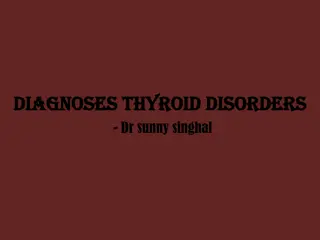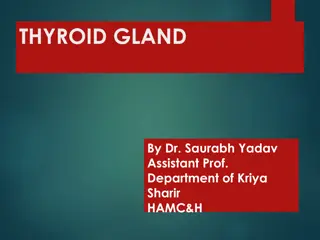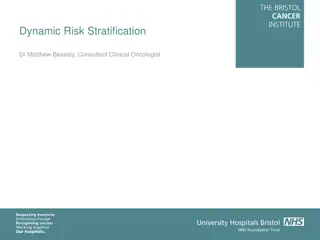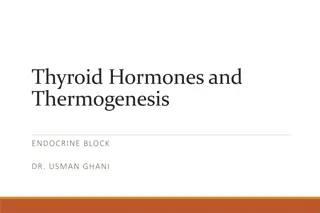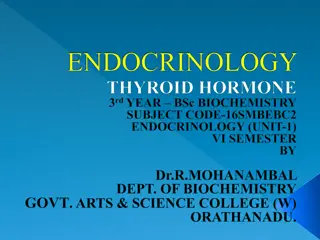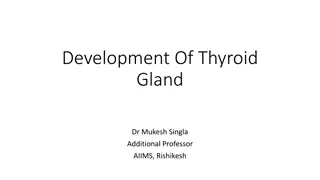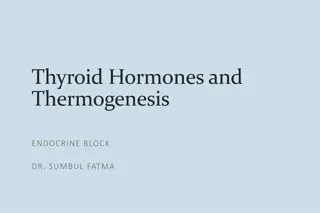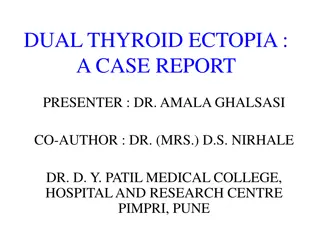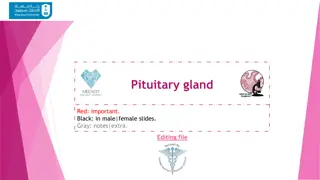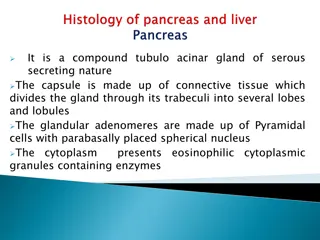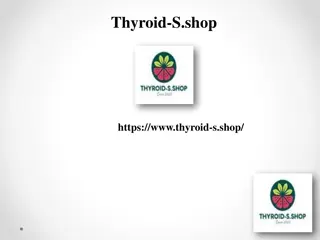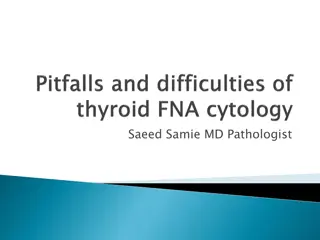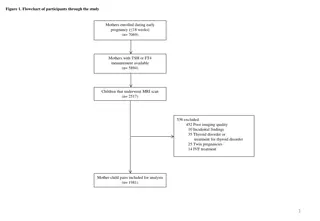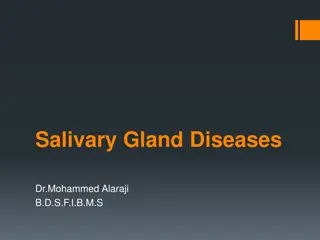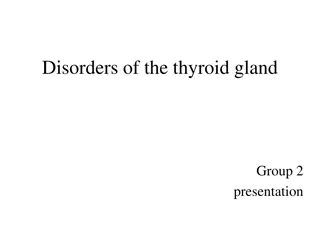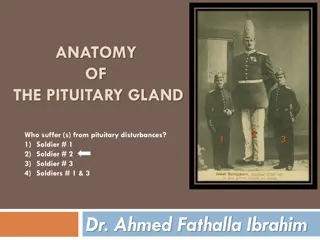Thyroxin and Functions of Thyroid Gland
Thyroxin hormone plays a crucial role in regulating body metabolism. Administration of thyroxin boosts oxygen consumption and heat production. The thyroid gland's functions include managing production of thyroxin, leading to hyperthyroidism or hypothyroidism. Disorders such as cretinism and myxedema can result from thyroid hormone imbalances. Parathyroid hormone regulates calcium levels in the body, while excess calcitonin prevents overshooting of blood calcium.
Uploaded on Sep 17, 2024 | 0 Views
Download Presentation

Please find below an Image/Link to download the presentation.
The content on the website is provided AS IS for your information and personal use only. It may not be sold, licensed, or shared on other websites without obtaining consent from the author.If you encounter any issues during the download, it is possible that the publisher has removed the file from their server.
You are allowed to download the files provided on this website for personal or commercial use, subject to the condition that they are used lawfully. All files are the property of their respective owners.
The content on the website is provided AS IS for your information and personal use only. It may not be sold, licensed, or shared on other websites without obtaining consent from the author.
E N D
Presentation Transcript
thyroxin. The control of this hormone is on the rate of body metabolism. When thyroxin is administered, the rate of oxygen consumption increases, the amount of heat produced is also increased.
functioning of the thyroid gland. Some are associated with excessive production of thyroxin i.e. hyperthyroidism and some with insufficient production of hormone i.e. hypothyroidism.
normal physical or mental development. Cretinism is prevalent in areas where insufficient iodine is present in diet. Symptoms of creatinism can be prevented by early and regular administration of thyroxin.
myxedeme. The symptom of this disease is low metabolic rates, overweight and a coarsening of the features. It is also prevalent in iodine deficient areas.
neck caused by swelling of the thyroid gland. This occurs when the thyroid gland is stimulated by TSH (Throid stimulating hormone from the pituitary gland) to produce thyroxin under a condition of insufficient iodine.
glands. They secrete PTH parathyroid hormone. This hormone promotes (a) the release of Ca++from the bones (b) the absorption of Ca++from the food in the intestine (c) reabsorption of Ca++in the tubules of the kidney.
Parathyroid hormone inhibits the reabsorption of PO4in the kidney tubules and thus helps rid the body of excess PO4produced.
excess of Ca++in the blood is calcitonim which is produced in the thyroid gland. This prevents the overshooting of Ca++level in the body.
second modification into 1, 2- dihydroxy vitamin D. This enhances the absorption of Ca++ from the intestinal contents. Thus this hormone teams up with PTH (Parathyroid hormone) and calcitonin in the regulation of calcium metabolism. Lack of calciferol prevent normal deposition of calcium in bone. In child hood lack of calciferol leads to deformed bones characteristics of rickets. In adult inadequate amounts of
parietal cells of the stomach secretin and Pancreozymin is secreted by cells in the stomach. These hormones when in the pancrease, stimulate the secretion of the various component of the pancreatic digestive juice and when in the liver and gall bladder they stimulate secretion and release of bile.
protein. Insulin acts to lower the level of glucose in the blood stream. One of the ways in which this is achieved is through the speeding up of the conversion of glucose into glycogen and fats in the liver.
Insulin also stimulates the synthesis of proteins, including enzymes that participate in carbohydrates metabolism.
converted to glucose. Victims also urinate copiously and frequently. The second pancreatic hormone is glucogen which also stimulates the conversion of liver glycogen into glucose. Glucogen may act to present insulin from lowering the blood sugar level excessively. Glucagen thus play a role in establishing a constant level of glucose in the blood.
structured located at the base of the brain. In adult vertebrate it consists of the interior and posterior lobes, the intermediate lobe being vestigial.
in the chemical coordination of the body. It is often called the master gland because many of its secretion control the activity of other endocrine glands.
promotes the growth of muscle, cartilage, bone and other connecting tissues. HCH is normally active in this respect only during the years of childhood and adolescence. Hyposecretion i.e. undersecretion of HGH in the child results in stunted growth or dwarfism. A hyposecretion of HGH during this same period results in giantism.
hormone secreted by the females during and after pregnancy. It stimulates the development of the mammary glands during pregnancy and following child birth, and the production of milk by them.
thyroid gland to secrete thyroxin. The secretion of TSH is in turn depressed by thyroxin, thus there exist a homeostatic control mechanism over the level of thyroxin in the blood.
Adrenocorticotropic Hormone (ACTH): This is a protein hormone, and it stimulate the cortex and the adrenal gland to release some of its hormone into the blood.
ovary. In conjunction with another pituitary hormone luteinizing hormone (IH), it stimulates the secretion of estrogen by the follicle and the ripening of the egg within it. FSH in human male stimulates the development of seminiferous tubules and the production of sperm.
released) into corpus luteum. This LH also stimulates the corpus luteum to secrete its hormone progesterone. LH in males stimulates the release of male sex hormones (androgens) (by the interstitial cells of the testes) into the blood stream.
whose target cells are the melanocytes, cells which contain the black pigment melanin. Increase in MSH cause some darkening of human body during pregnancy.
contraction of smooth muscles, especially those of the uterus. Infection of oxytocin hastens delivery of the baby and also hasten the return of the uterus to its normal size.
blood pressure. ADH also stimulates reabsorption of water from the tubules of the kidney insufficient production of ADH causes enormous loss of water through the kidneys. This disease is known as diabetes insipidus. Copius urine produced by hyposecretion of ADH is very watery and has no marked taste.
hypothalamus are: (i) Thyrotropin releasing hormone (TRH). This hormone stimulates the anterior lobe to secrete TSH (Thyroxin, stimulating hormone) (ii) gonadotropin releasing hormone (GNRH) stimulates the anterior lobe to secrete LH (luteinizing hormone) and FSH. Hence it can be called LH-releasing hormone (LH RH) (iii) Somatotropin-release-inhibiting- factor SRIF or stomatostatin: This polypeptide inhibits the secretion of
situated one at the top of each kidney. Each consist of two parts the exterior portion is the adrenal cortex while he interior portion of the gland is adrenal medulla.
considered to be a part of the nervous system. Its secretory cells seem to be modified nerve cells. Two hormones secreted by adrenal medulla are adrenaline and noradrenaline.
increased, thus increasing the blood pressure. A larger part of the blood supply of the skin and viscera is shunted to the skeletal muscles, coronary arteries, liver and brain. The level of blood sugar rises and metabolic rate increases. The bronchi dilates, permitting easier passage of air to and from the lungs. The pupils of the eye dilate and there is tendency for the body hair to stand.
increase in blood pressure by stimulating the contraction of the arterioles. Almost all the body responses to these two hormones can be seen to prepare the body for violent physical action.
Most of the hormones of this gland are steroids (lipids). These hormones fall into the two major groups viz: glucorticoids and mineralocorticoids.
thus causing the level of blood glucose to rise. One of the chief target organs in this response is the liver. The glucorticoids also act to suppress inflammation in the body. They are needed to maintain the body during period of stress after the fruit brief adrenaline stimulated response when the levels of glucose and salt in the blood drop sharply.
in humans, is to promote the reabsorption of Na+and Ci-ions in the tubules of the kidneys. Retention of these ions in the blood keeps its osmotic pressure high. This in turn, assures normal blood pressure.





